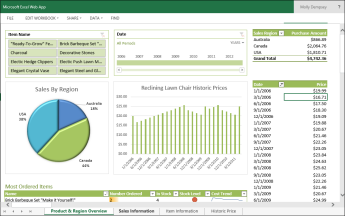
Aug 7, 2014.. Power BI We have been comparing features of SharePoint Office 365.. who rely on in depth data analysis may find Power BI too limiting. In this ..


Dec 19, 2014.. Microsoft beta tests Power BI dashboards, visualizations, connectors, and an iPad app just as IBM launches a rival cloud-based BI service.
Note The information in this article applies to Excel 2013 and SharePoint Online in Office 365 Enterprise. If you’re looking for information about Excel Services in SharePoint Server 2013 (on premises), see Business intelligence in Excel and Excel Services (SharePoint Server). Business intelligence capabilities are not supported in Office 365 operated by 21Vianet.

Welcome to Power BI Features in Depth. In this course we'll use two different Excel 2013 Tool Set. The four self-service BI Tools that only require Excel and the Power BI tools that work with Office 365. First, I'll show you how to use Excel 2013 and the free add ins Power Pivot, Power Query, Power View, and Power Map to connect to data sources online and on your computer, build data models that are powerful, and summarize, analyze and present your data in tables, charts, maps, and reports. Learn how you can easily search, access, and analyze data inside and outside of your organization in just a few clicks with Power BI—the business intelligence features that lie inside Microsoft Office. Author Gini Courter walks you through two toolsets: the self-service BI tools that only require Excel, and Power BI, which relies on Office 365. Using the Power Query, Power Pivot, Power Map, and Power View tools in Excel 2013, you'll learn to connect to local and remote data sources, model that data, and present your findings in the form of tables, charts, maps, and reports. Then Gini switches to Power BI to enhance and share the queries and reports you just created. As you'll soon find in the course of these tutorials, Microsoft's BI tools allow you to use the software you already know and love to analyze and share complex business data. Understanding data analysis and business intelligence Installing Office BI add-ins Searching for online data with Power Query Shaping data in the Query Editor Connecting to data sources Modeling data with Power Pivot Enhancing PivotTables and PivotCharts with PowerPoint Visualizing geospatial data with Power Map Creating and formatting Power View reports Sharing your data using Power BI for Office 365 Welcome Welcome to Power BI Features in Depth. In this course we'll use two different Excel 2013 Tool Set. The four self-service BI Tools that only require Excel and the Power BI tools that work with Office 365. First, I'll show you how to use Excel 2013 and the free add ins Power Pivot, Power Query, Power View, and Power Map to connect to data sources online and on your computer, build data models that are powerful, and summarize, analyze and present your data in tables, charts, maps, and reports. Then we'll switch to power BI and see how you can share those queries and reports that you've already created using the new Office 365 Power BI tools. If you're comfortable with Excel features like tables, charts, and pivot tables and are ready to do more with your data, then I designed this course for you. Let's get started.


